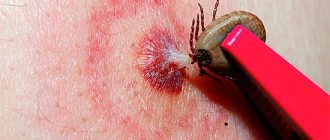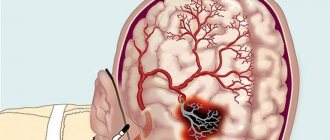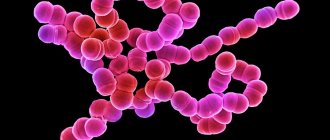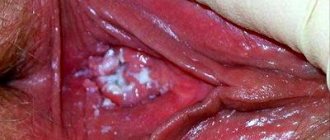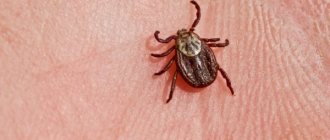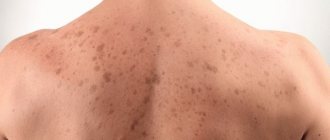Ticks are small arachnids, the average size is only half a millimeter! They become more active during the warm seasons of spring and summer; dry and hot weather means an increased risk of being bitten. The danger of ticks is that they carry viruses that are deadly to humans. For example, Lyme disease, tick-borne encephalitis, tick-borne typhus, tularemia, ehrlichiosis. We have collected photographs of what tick bites look like on a person’s body so that you can recognize the enemy by sight. We will also give advice on how to protect yourself and your family, and how to remove the parasite from the victim’s skin after a bite.
Forest tick: how to recognize the threat
The forest tick is the most dangerous and aggressive species; it feeds on blood. Its bite can cause serious harm to the human body. Lives in forests and park plantings, attacks both people and animals. In winter it hides in the ground, tree cracks and fallen leaves, but with the onset of a thaw it comes out to hunt. The active season for ticks begins in the spring; it is during this period that people are most at risk of catching the parasite. Tick season lasts from spring to fall.
See the page: Ticks in the Moscow Region, especially dangerous areas are described there.
The tick resembles a tiny beetle, its body length is only 4 mm, has 4 pairs of legs, and is covered with a shell on top. Since the arthropod is very small, it is very difficult for a person to see its head and blood-sucking proboscis without special devices. Although the forest tick does not have eyes, it can smell its prey at a distance of up to 10 meters, thanks to its well-developed sense of smell. The male's body is smaller than the female's. The female, having drunk blood, can reach up to 2 cm in diameter; she is able to drink blood 10 times her own weight.
Photo of ticks - female on the left, male on the right.
Many people are afraid that a tick may fall from a tree and burrow into the scalp or neck, where it is very difficult to detect instantly. It is a myth. The forest tick does not rise above 50 cm from the ground, so this possibility is excluded. Often, a tick waits for a warm-blooded creature in the grass or on a bush, and when it comes closer, it grabs it with its front paws and climbs up quite quickly. The parasite travels throughout the victim’s body, choosing the most convenient areas with access to blood (most often the stomach, groin, neck, armpits). Then it digs into the skin, cutting it with its proboscis, and begins to suck out the blood.
What happens when a parasite is sucked on?
Ixodid ticks bite exclusively to feed on blood - this is their only source of food. To saturate the parasite needs:
- Get caught on the victim’s clothing or fur;
- Get to a place convenient for blood sucking;
- Pierce the skin and attach to the wound;
- Suck blood;
- Detach and leave the host's body.
It is important to understand that there are almost never situations in which a tick bites, but does not have time to attach itself and crawls away.
In general, finding a host and securing it in its skin is a complex process. The tick is usually found at the top of a grass stem with its front pair of legs extended forward. When a person or animal approaches, the parasite instantly grabs onto the host.
Then, from 2-3 minutes to an hour, the tick moves around the host’s body and looks for well-supplied areas with thin skin. Then the bite occurs:
- The parasite places the palps to the sides, which normally act as “sheaths” and cover the hypostome;
- The hypostome and chelicerae penetrate the skin;
- It releases saliva into the wound, containing many functional components (this includes anticoagulants that prevent blood clotting and thickening, painkillers, compounds that envelop the hypostome and partially spread in the intercellular space, gradually harden and form a kind of case that very reliably holds the parasite in the skin );
- Then the tick begins to suck blood, lymph and inflammatory infiltrate from the wound.
The photo below shows the proboscis (hypostome) of a tick:
And this is what a hypostome looks like under a scanning electron microscope:
Representatives of different species of ticks and individuals at different stages of their life cycle tend to choose different places on the body of the host for attachment. On the human body, these are most often the armpit areas, and then, in descending order of frequency of attachment, the following areas follow:
- Breast;
- Stomach;
- Hands (including between fingers);
- Buttocks and perianal area;
- Groin;
- Legs;
- Neck and head (especially the area behind the ears).
The photo below shows a tick attached to a child’s ear:
And here the parasite got into his throat:
It is noteworthy that in children, ticks are more often than in adults, attached to the head (including in the hair, often behind the ear) and sometimes even on the face - on the cheeks, on the chin.
At the same time, the areas of attachment are largely determined by how the person is dressed. If, for example, his whole body is covered with thick clothing, then the parasite can reach his head from his feet and attach itself here.
The duration of blood sucking depends on the sex of the parasite and the stage of its development. Thus, tick nymphs of all ages feed at each stage of their development for 3-6 days, and female nymphs feed on average a day longer than male ones. Adult males feed for about the same amount of time - 3-6 days, and adult females - on average from 8 to 14 days.
This is interesting
Some types of ticks can feed for either much less or much longer periods of time. For example, the larvae of Haemaphysalis kitaokai become engorged within 2-3 hours, and the females of Geochelone pardalis, which parasitize turtles, fall off on average only 60 days after attachment.
It is noteworthy that while feeding, the tick does not constantly suck blood. Short acts of sucking are followed by periods of rest, then by injecting another portion of saliva into the wound. Studies have shown that no more than 15% of the time the parasite is attached to the host is spent directly on blood sucking. This indicates a certain primitiveness of this method of feeding and to a certain extent reduces the survival rate of feeding ticks.
It is also useful to read: Devices for removing ticks: choosing an effective remover
The photos below show female ticks engorged with blood:
Throughout the entire period of bloodsucking, the parasite not only fills the digestive tract with blood and inflammatory infiltrate of the host, but at the same time actively grows and develops. In nymphs, it is at this time that the rapid development of internal organs and the growth of body integument occurs, and in adult males and females, the maturation of the reproductive system occurs.
Therefore, by the way, during one feeding each tick sucks out more blood and other liquids than it weighs at the time of detachment. Within a few days of feeding on the host, most of the food consumed has time to be digested and spent on development and growth, and undigested components are excreted in excrement. As a result, female ticks, weighing 7-10 mg before feeding, absorb about 5500-8500 mg of food during attachment, but weigh only 900-1400 mg after falling off.
This is interesting
Almost no environmental factors can force an unsatiated tick to detach from its host. The fact is that the very fact of getting on the host’s body and attaching to it is a vital necessity for each individual individual. Thus, one female lays several thousand eggs, and not all of them are fertilized and only a portion hatch into larvae.
Of several thousand larvae, only a few will be able to find the first host, and all the rest will die either from hunger or from predators. Likewise, of the several thousand larvae that have molted into the first instar nymph, only a few will be able to feed on the next host. As a result, for every adult tick that attaches itself to a person or animal, there are millions of its dead counterparts who did not manage to do so. Therefore, it is biologically conditioned that if a tick has attached itself, it will detach itself only after saturation, and it is impossible to force it to do this earlier. He would rather die than miss the chance to be satiated to the end.
It is for this reason that methods of removing attached ticks using hot matches, oil or repellents are ineffective. Even if burned or suffocated by a drop of oil, the tick will not let go of its victim.
If the tick is full, it independently removes the gnathosoma from the skin. What will happen to it next depends on the type of parasite and the stage of development of the individual:
- In one- and two-host ticks, nymphs and larvae can remain on the host’s body, molt here, and after moving to the next instar, attach themselves again. This happens most often when parasitizing cattle;
- Adult males of some species, after detachment, go to look for females that have attached themselves to the same host in order to copulate with them. The photo below shows a lot of attached ticks of different ages in the dog’s ear;
- In three-host species, after each saturation, the larvae and nymphs fall away from the host, look for secluded shelters in the ground and under stones, where they molt, and sometimes overwinter, and then go in search of new hosts;
- Adult females of all species, after satiation, disappear and hide in random shelters on the ground. Here they wait for the eggs to fully mature and lay them, after which they die.
It is interesting that if in nymphs of all ages, larvae and adult males, nutrition contributes to the general development of the body, then in adult females, when feeding, the reproductive system first fully matures, and after fertilization, degradation of the digestive system begins with the parallel development of a large number of eggs. In fact, after complete saturation and development, the adult female is a living egg sac, practically incapable of further life. She can still move a short distance to find shelter on the ground, but here, after laying eggs, all that remains of her is actually the mouthparts and the shell of the idiosome.
Adult males also do not live long after feeding, but their lives are a little more eventful. They actively search for females, fertilize them, and can feed them several times. However, engorged adult males no longer survive the change of seasons and do not live to see the next year.
Signs of a tick bite, symptoms and consequences
The condition of the victim depends on the number of bites and physique. They are more difficult to tolerate for the elderly, children and people with severe and allergic diseases. Possible signs of a bite in a person:
- redness, itching;
- increased body temperature;
- the appearance of headache;
- lowering blood pressure;
- increased heart rate;
- the appearance of skin rashes;
- enlarged lymph nodes;
- constant feeling of weakness.
The consequences of the attack depend on whether the parasite is infected or not. The most dangerous thing for humans is the bite of an encephalitis tick.
The consequences of such a bite are extremely severe (in case of infection and refusal of treatment):
- paralyzes the body;
- breathing problems occur;
- brain activity decreases;
- Possible death.
If a person has suffered from a “sterile” tick, then the complications may not be so dangerous:
- suppuration of the affected area;
- the occurrence of an allergic reaction;
- the appearance of edema, even Quincke's edema is possible.
Svetlana Tolstova
Infectious disease specialist, therapist with 15 years of experience in a city clinic.
Ask a Question
It is impossible to independently determine whether an infectious tick has embedded itself or not. Their appearance and color do not depend on whether they are infected or not. If you are bitten by an infected tick, prompt treatment can save the victim's life.
How long does it take for symptoms of a tick bite to appear in humans?
The first symptoms appear after 2-3 hours in the form of redness of the skin. After a week or later, the symptoms described above may appear.
Prevention of bites
In order not to think while visiting a forest, park or cottage about whether a tick has bitten or not, and what consequences this may lead to, preventive measures should be taken to protect children and adults from this problem:
- wear light-colored clothing on which crawling insects are clearly visible, with long sleeves and close-fitting cuffs;
- treat clothes with repellents or repellent acaricidal sprays, the odors of which ticks cannot tolerate;
- beware of walking or sitting in tall grass, where parasites lie in wait for their prey to climb on it;
- before visiting an area where tick-borne encephalitis is common, it is recommended to get a preventive vaccination to develop immunity;
- After a walk, carefully inspect your clothes and skin for attached parasites.
The given recommendations will allow you to avoid attacks by “bloodsuckers” and possible negative consequences.
How is a tick bite different from other insect bites?
How to find out which insect bit and left characteristic marks on the skin? There will be only one spot, there will be no similar ones in the neighborhood, the redness will increase every hour, and an allergic reaction may occur. Bedbugs, for example, bite in several places at once, and fleas too. The bite of a mosquito and midge is much smaller than that of a tick.
What does the bite site look like?
A tick bite (symptoms in humans usually do not appear immediately) on the skin may appear as a small red spot with slight swelling, and there may be slight itching.
A tick bite (photo) can pass without symptoms or consequences for humans!
This reaction is caused by trauma to the skin and the action of arthropod saliva, which often causes an allergic reaction. Symptoms disappear after 3-5 days, provided that no infection has occurred.
When a person is allergic to insect secretions, the bite site can become very swollen and inflamed. If the tick was a carrier of borreliosis, then a circle with a diameter of 10 to 20 cm (in rare cases can reach up to 60 cm) with a red border is formed around the bite, and in the center the skin may acquire a white or bluish tint. Symptoms disappear after about 14 days.
The tick sticks mainly where there is thin skin, these are:
- groin area;
- neck and behind the ears;
- stomach or lower back;
- in the armpits and chest area.
It is important that an examination by a specialist, as well as submitting the tick to a laboratory, are necessary, even if there is no deterioration in health and the bite site is quickly restored. Some types of transmitted diseases have a long incubation period.
Why do ticks drink blood and how much do they need?
Ticks drink blood in order to get enough and leave offspring. Females will not be able to lay eggs in a hungry state; they definitely need blood.
How long can a tick suck blood? From several minutes to several hours, and females, as a rule, stay on the victim’s body longer. It should be noted that most of the time the tick is on the skin of a person or animal, looking for a place to suction, so if the tick has not yet latched on, you need to brush it off as soon as possible (no need to squash it on yourself like a mosquito, you can get an infection under the skin) . On average, an adult sucks blood for 1-2 hours, after which it disappears.
Types of "bloodsuckers"
The most common types of ticks found in Russia:
- Ixodidae (lat. Ixodidae) are the most dangerous to humans, they belong to the blood-sucking family that parasitize animals. Its largest representatives in the normal state have a length of 1.3 cm, and after consuming a portion of blood - up to 2.5 cm, as can be seen in the photo of a sucked tick. After inserting itself under the skin, the tick is fixed there with the help of a special outgrowth in the mouth, so when pulled out, the head of the parasite remains in the host’s body.
- Demodex or subcutaneous - refers to opportunistic pathogens that constantly live on human skin on the face and other areas. It lives at the base of hair follicles and feeds on skin particles and sebum secreted from the glands. Activation of subcutaneous mites occurs with a decrease in immunity or hormonal imbalance and is expressed in the inflammatory process and the appearance of pimples and ulcers. The smallest dimensions of demodex (0.3 mm) make it possible to see the attached mite under the skin in the photo only at high magnification under a microscope.
- Bed parasites or dust parasites (size 0.1-0.2 mm) - live only in bed linen. Their diet consists not of blood, but of dead skin particles. Leaving the results of their vital activity on the human body, such small mites are capable of causing a strong allergic reaction on the body of their victim. Photos of ticks are presented below.
Types of ticks
How much blood can a tick drink at one time?
Hungry ixodid ticks weigh from 2 to 15 mg, and saturated ones from 200 to 1200 mg, which is many times their own weight. In one bite, a tick can pump out up to 1000 mg of human blood. The size of a hungry tick does not exceed 4 mm, and a well-fed one can reach 3 cm, becoming similar in size to a corn seed.
The photo compares two ticks on a cat’s body – one that has recently been sucked on and one that has already drunk blood.
A few more photos
A tick has attached itself to a child's ear:
And this photo shows signs of an allergy to a tick bite:
Removing a tick with a thread:
Interestingly, ixodid ticks parasitize not only warm-blooded animals, but also reptiles:
How dangerous is a tick bite for humans?
An attack by an uninfected tick is not fatal and is relatively safe for human health. Severe diseases can only be transmitted if the parasite has been infected with viruses or bacteria.
A tick can serve as a carrier of a fairly extensive list of diseases, so after removing the tick, it is better to save it for tests to determine infections (encephalitis, borreliosis, called Lyme disease), this is done in the laboratory at the infectious diseases hospital. It is worth noting that the presence of viruses in an insect does not guarantee that the bite victim will also get sick. It is necessary to examine the insect for peace of mind if the result is negative, and for timely treatment if the infection is confirmed.
The most commonly transmitted and pose a huge threat to human life are tick-borne encephalitis and borreliosis. Scientists have proven that the chance of becoming infected from a tick is unlikely, since 90% of ticks, according to research, are not infected. Although minimal, the chance exists.
Is it possible to get infected from a tick if it crawls across your body?
If a tick simply crawls across the surface of the skin, it is impossible to become infected from it. The first stage of infection begins precisely from the moment the tick suctions and injects an anesthetic substance under the skin. So if a tick is crawling on you, brush it off as quickly as possible and, if possible, kill it with fire.
Doctor's opinion
Ticks themselves are not dangerous. After their bite, there may be a slight redness that disappears within a few days. With the development of a local allergic reaction, slight increases in temperature are possible. There are no serious consequences.
However, it must be borne in mind that ticks are carriers of a large number of infections. The most terrible of them are encephalitis and borreliosis. Pathologies can have a significant impact on human health and even lead to death. Therefore, tick bites should not be ignored. Faced with this, it is necessary to remove the arthropod from the body and then take it to the laboratory for research. The person himself must carefully monitor his well-being. Any change is a reason to immediately contact a specialist.
Bitten by a tick - what to do: first aid
If a tick is crawling on you, shake it off immediately, and if it has already attached itself, remove it as soon as possible and store it in a jar with moistened cotton wool or blades of grass to deliver it alive to the laboratory to test for infection.
Treat the wound with an antiseptic. If signs of an allergy are observed - severe redness and swelling of the bite site, immediately give the victim an antiallergic drug. You can purchase the drugs “Zyrtec”, “Suprastin”, “Prednisolone” (smear the bite site): the dosage regimen of the drugs is individual. The effect of one tablet is enough for a whole day. These antihistamines are actively used to eliminate the allergic consequences of a bite. Taking the tablet is not recommended if you are hypersensitive to the components. Hypokalemia, sleep disturbances, flatulence and negative nitrogen balance may develop.
Svetlana Tolstova
Infectious disease specialist, therapist with 15 years of experience in a city clinic.
If the encephalitis virus has entered the human body, the drug Ribonuclease is prescribed for treatment. The medicine is administered 6 times a day intramuscularly, in a hospital setting. The dose is prescribed by the attending physician. The use of Ribonuclease is not recommended for respiratory failure, tuberculosis and bleeding. There is a risk of developing allergic conditions. Do not use the drug without a doctor's prescription!
Effective methods for treating bites
The body of many people responds adequately to bed tick bites, and they heal on their own within a few days. There are people when they need to provide emergency assistance, since their body reacts very specifically. In cases where atypical reactions occur, it is necessary to:
- Thoroughly wash the bite areas with soap or soda solution, after which they are rinsed with clean running water. To prepare the solution, you need to take a glass of water and add to it a tablespoon of soda or liquid soap.
- Bite areas should be disinfected with any alcohol-containing product, such as vodka or moonshine, cologne or perfume.
- Severe itching indicates an allergic reaction. To reduce these symptoms, you can use both pharmaceutical and folk remedies.
Folk remedies
There are a number of effective and proven recipes. For example:
- Bite areas should be wiped with pure vinegar. There is no need to rinse off the product.
- You can apply a piece of ice or some product from the freezer to the bite site.
- If you apply a used bag of black or green tea to the site of the bite, this will relieve the victim of discomfort.
- Lotions are also made based on medicinal herbs. St. John's wort is considered the most effective remedy. To prepare the solution, you need to take a tablespoon of St. John's wort and pour a glass of boiling water. After the infusion has cooled, a cotton pad is soaked in the infusion and applied to the wound for half an hour. Herbs such as chamomile or calendula are suitable. The product is prepared in the same way as using St. John's wort.
- Treatment with a composition based on aloe and plantain. After mixing the ingredients, the wound is treated several times a day. The juices of these plants help reduce swelling of the bite site, reduce itching and have an antibacterial effect.
- Onion and garlic juice combined together act on the bite site in a similar way. The smell of onions and garlic, in addition to relieving discomfort, helps repel these bloodsuckers.
- You should drink at least 5 tablets of activated carbon to remove toxins from the body as quickly as possible.
As a rule, folk remedies help a person cope with negative consequences in the initial stages. If these remedies do not cope with the task, then you should use pharmaceutical remedies. Alternatively, you can use essential oils, which have the same effect as herbal infusions.
Recommended essential oils from plants such as:
- Lemon.
- Orange.
- Lavender.
- Geranium.
- Tea tree.
- Needles.
- Juniper.
- Cypress.
- Sagebrush.
- Mint.
Medications
There are both special remedies developed for the bites of various insects, and non-special ones, but which cope with this task. The thing is that each body reacts differently to bed tick bites.
As a rule, the following pharmaceutical products are used:
- Special ointments “Fenistil” and “Rescuer”. These remedies have a wide spectrum of action and help relieve the victim of negative consequences.
- Vietnamese star, which is characterized by the manifestation of an antibacterial effect.
- Afloderm helps to cope with severe itching.
- Propolis tincture is effective against any bites.
- Afloderm ointment is used with Tavegil, which helps relieve the symptoms of allergic reactions.
- The “Tsindol” talker will easily cope with the task.
- Akriderm perfectly relieves signs of inflammatory processes.
How to remove a tick?
The arthropod parasite attaches itself very firmly to the human body, since the tick's saliva acts like glue. The proboscis digs deep into the skin, so removing the tick must be done very carefully. Stores (usually pet stores) now sell convenient tools for twisting ticks.
Step-by-step recommendations for removing a tick:
- Using counterclockwise movements in a circle, as if unscrewing a self-tapping screw, pull it out of the skin using tweezers. Be careful that the head of the tick does not come off.
- If you had to remove the bloodsucker in nature, and there were no tweezers nearby, an ordinary thread will help. With its help, the proboscis is tied near the very surface of the skin and pulled out with light jerks.
- After removal, you need to make sure that the tick is intact, put it in an airtight container and deliver it to the clinic for analysis as soon as possible.
- Lubricate the surface near the bite with any antiseptic.
Svetlana Tolstova
Infectious disease specialist, therapist with 15 years of experience in a city clinic.
People often advise treating the affected area with oil, kerosene, gasoline and other liquids so that the tick comes out on its own. This action is wrong - the tick will try to dive even deeper under the skin. But if the insect crawls out after this, its body cannot be examined in the laboratory.
Why do bed mites appear in the house?
These parasites do not like sunlight and prefer to live in dark places in the home where there is no flow of fresh air. As a rule, they live not far from the places where people constantly rest. These are places such as the head of the bed, mattresses, furniture, soft toys, and household appliances. The parasite is activated at night, when a person is sleeping, and sleeping soundly. It is not at all difficult to understand that bed ticks have appeared in the house, since a multiplying bloodsucker causes serious harm to a person. They prefer to drink the blood of women and small children.
These parasites enter the home in various ways. For example:
- From neighboring apartments, when the owners of these apartments begin to fight this parasite. When there are too many of them, they themselves look for a new source for their existence.
- Using various things, including used ones. This is especially true when owners buy old sofas, armchairs or old furniture, as well as linens and clothes. Sometimes the owners themselves bring parasites after returning from a business trip, when they stayed overnight in hotels where they are not properly combated.
- With household appliances, both new and used. Often no one follows sanitation rules in warehouses. Under certain conditions, they begin to take on household appliances, not to mention used appliances.
- From the street on clothes, as well as on the fur of pets that are walked on the street. Animals love to visit places where ticks may be found. This is tall grass, basements, trash cans, etc.
As you can see, there are plenty of ways of infection, so it is better to use some recommendations that will help protect your home from parasites such as bed mites. If you start the fight in a timely manner, when they have not yet had time to multiply to countless numbers, this will simplify the task, since coping with a large colony is much more difficult.
How to recognize bed bug bites
What to do if the tick head remains under the skin?
The tick's head may remain under the skin if it is removed carelessly or too quickly. It looks like a small splinter, so some people are negligent about removing it, saying “the tick is dead, it no longer sucks blood, it will fall off on its own,” or they simply don’t notice. But this is not recommended. Remaining under the skin, the tick's proboscis will provoke inflammation and suppuration of the wound. Therefore, do not leave the head or proboscis of the tick under the skin, waiting for them to fall off on their own.
Take a sharp needle disinfected in alcohol and pick up the remaining proboscis and remove it. After a bite, a small wound will remain on the skin, which will heal quickly if the tick was not infectious. Treat the bite site with peroxide, then brilliant green or iodine. If the tick bite area is very itchy, use Fenistil Gel or a similar itching reliever. Try not to scratch the inflamed area to speed up the healing process.
To prevent the head of the tick from remaining under the skin, catch it as close as possible to the suction site
The structure of the parasite's mouthparts
The oral apparatus of a tick is a complex formation and consists of several components, each of which has its own morphology and functions. You can examine some interesting nuances in detail under a microscope (see photo below):
The oral apparatus includes a base, a proboscis or hypostome, one pair of chelicerae embedded in cases, and a pair of palps. The base of the proboscis has the form of a capsule with a dense chitinous cover - here the ducts of the salivary glands pass and the pharynx begins. The palps have a segmented structure, consist of 4 segments and perform a tactile function.
The hypostome is an unpaired chitinous plate immovably attached to the base. It has the appearance of an elongated “sting”, on which a large number of hooks bent back are located in regular longitudinal rows, as shown in the photographs below:
Towards the top, the hooks become smaller, forming a crown of small and at the same time very sharp thorns. When a tick bites, the sharp hypostome is involved in cutting through the skin along with the chelicerae.
The back-directed teeth of the proboscis do not interfere with its penetration into the integument, but they prevent the reverse forcible removal of the attached tick, acting as an anchor. Therefore, in no case should a tick be forcibly pulled out of the skin with a sharp movement, as this risks that the proboscis (or even the entire head of the parasite) may remain under the skin, causing suppuration.
On a note
At the base of the hypostome a pair of chelicerae are attached, which look like sharp blades enclosed in cases. Chelicerae are very mobile and can cut through the skin and integument at different angles and to different depths. When at rest, they are enclosed in cases that protect them from mechanical damage.
Collectively, this is called the gnathosoma and represents the anterior section of the tick’s body, which, during a bite, plunges into the integument of the victim’s body.
What disease can you get from a tick bite?
After a tick bite, a person develops various ailments - from ordinary irritation to severe or fatal illness:
- Tick-borne encephalitis: at first the disease resembles a common cold. The incubation period can last up to a week. No analysis will provide one hundred percent information about the infection if 10 days have not passed since the attack. To make an accurate diagnosis, you need to bring a live and unharmed parasite for examination. More information about encephalitis is on Wikipedia.
- Borreliosis (Lyme disease): This disease can be transmitted to humans if the tick contains Borrelia bacteria. Symptoms do not appear immediately, after a while the lymph nodes become enlarged, the body aches, and a red ring appears on the skin as in the photo. Read more about the disease on Wikipedia.
Tick bite mark indicating Lyme disease infection
Modern drugs can completely cure infections that are transmitted by ticks, provided they are detected early and treatment is started immediately.
Possible consequences
The consequences of a bite directly depend on whether the tick was infected. If it is absent, the patient may experience itching for some time. Sometimes a local allergic reaction occurs, which is manifested by redness of the skin and fever. All symptoms go away quite quickly.
If the tick is infected, serious illness can develop after the bite. As a result, most systems and organs can be affected. The most serious consequences are caused by infection with encephalitis. With the most favorable outcome, it will be possible to completely get rid of the disease only after 2 months. The average stage lasts for 6 months. Signs of severe infection will disappear after 2 years. If events develop unfavorably as a result of an encephalitis tick bite, a person’s quality of life may deteriorate on an ongoing basis. Possible deterioration of motor functions and the occurrence of epilepsy. In the most severe cases, death can occur.
Signs of infection with tick-borne encephalitis
According to doctors, the symptoms of this encephalitis are detected after 10-14 days from the moment the tick bite was discovered in the victim. What to do? There is no need to panic; often elevated body temperature and muscle pain can be a manifestation of the body’s protective psychological response after fear and anxiety.
Once the disease begins, it goes through certain stages:
- Unreasonable and short-lived chills, increased body temperature up to 40 degrees. According to the clinical signs of the formation of encephalitis, this period is more similar to influenza infection.
- After some time, the patient may experience symptoms: nausea and vomiting, attacks of severe headache. At this stage, all symptoms indicate a gastrointestinal disorder.
- After a few days, the patient suddenly develops symptoms of arthritis or arthrosis. The pain in the head goes away and is replaced by aches throughout the body. The patient's movements become very difficult, and breathing problems arise. The skin on the face and body becomes red and swollen, and purulent abscesses appear at the site of the bite.
- Further, the symptoms only worsen, because the infection enters the patient’s circulatory system and begins its destructive work. Delay can lead to death!
If an embedded tick is found on the body, it should be pulled out immediately. You can do this procedure yourself or go to the hospital. Health workers can easily remove it and run a series of tests. Only in laboratory conditions can one accurately determine whether this tick is dangerous. If treatment is necessary, you must unconditionally follow the recommendations and instructions of the attending physician so that the effectiveness of the treatment is maximum.
Periods of tick activity
With the onset of warm weather, many people flock to picnics in the forest, hoping for a pleasant time. But it is during the spring-summer period that the danger of getting a tick bite increases, which can lead to very serious consequences.
The danger persists throughout the entire period, from early spring, when the soil surface temperature is close to 0.30C, until late autumn.
Ticks appear with the first rays of spring. The peak of activity occurs in the warmest months of spring and summer. The maximum number of visits to medical institutions occurs in the period from the second half of April to July.
The Siberian and Ural federal districts are considered the most dangerous, based on the number of complaints, while the Southern and North Caucasian federal districts are considered more favorable.
Treatment of tick-borne encephalitis
If the diagnosis is confirmed, the doctor recommends comprehensive treatment to the victim. In the acute stage, strict bed rest with intensive therapy is prescribed, which helps reduce the amount of toxins in the body and weaken the active virus.
The victim is also injected intramuscularly with the drug “Gammaglobulin”. The sooner this serum begins to act, the faster the patient will experience improvements. The effect of the drug lasts for a day, after which the body temperature normalizes, the signs of encephalitis and meningitis decrease, and then completely disappear. To alleviate the signs of poisoning, you need to introduce fluid to restore electrolyte balance, and also start taking glucocorticoids.
Do not use the drug under any circumstances unless prescribed by a specialist!
If the arachnid fell off at home
In a situation where the parasite bites a person and falls off after a few hours, it often goes unnoticed. A red spot, slight inflammation, and slight itching remain on the body. The tick falls off if it has fully satisfied its need for food and replenished its nutritional reserves.
Tick drunk on blood
If a thick tick falls off at home, there is no future for it. The nymph will not be able to continue development because there is no soil. The female will not be able to lay eggs for the same reasons. After some time, the parasite dies. The tick is dangerous if it has not drunk blood, then it can bite again. There is no need to worry too much about where the tick goes in the apartment. Even if he is not discovered, he will soon die.
Where can I take a tick for analysis? Moscow laboratories
Listed below are laboratories where you can submit ticks for analysis in Moscow and the Moscow region; they conduct tests for encephalitis, borreliosis and other infections.
- FBUZ "Center for Hygiene and Epidemiology in the City of Moscow": metro station Alekseevskaya, Grafsky lane, building 4 (entrance from the yard, 2nd floor). Telephone
- Branch of the Federal State Institution "Center for Hygiene and Epidemiology in Moscow": metro station 1905 Goda Street, Krasnogvardeisky Boulevard, building 17 building 1. Telephone: 8 (499) 256-24-40
- Institute of Poliomyelitis and Viral Encephalitis: Moscow Region, Vnukovo, Moskovsky village. Telephone
- Children's Clinical Hospital No. 13 named after Filatov: metro station Barrikadnaya, Sadovaya-Kudrinskaya street, building 15. Telephone
- Infectious Clinical Hospital No. 2: Sokolinaya Gora metro station, 8th Sokolinaya Gora Street, building 15. Telephone
If you are afraid to remove the tick yourself, go to the emergency room, where they will professionally remove it and treat the wound. There you will also find out which laboratory the tick can be taken to.
Danger to humans
These blood-sucking creatures pose a great threat to humans, as they can infect dangerous diseases. In this case, it does not matter at all whether it is found on the body, or whether it drank blood and fell off on its own; it is its bite that is dangerous. Therefore, it is very important to contact medical institutions when it is detected.
If you manage to save the insect, you can submit it for analysis, which will show whether this individual is infected. If you remove it from the body yourself, then you need to put it in a glass container along with a piece of damp cloth, which will not allow it to dry out. Analyzes are carried out with live insects, which allows you to obtain accurate results. If the parasite is dead, burst, or there is only a fragment of it, then research can be carried out, but the result will not be accurate.
In cases where you have not noticed the tick itself on your body, then symptoms appear, consult a doctor immediately. These parasites can transmit diseases such as encephalitis and Lyme disease.
Lyme disease
This disease is manifested by such symptoms as fever, headache, body aches, weakness, and a cough and runny nose may also appear. These symptoms are similar to a cold or even the flu, so a person may not think about having a dangerous infectious disease. The main sign that you definitely need to pay attention to is the appearance of a large red spot on the body, which has a clear outline.
This disease affects the nervous and lymphatic systems. It is very important to start treatment at an early stage, since brain activity suffers, memory may deteriorate, and disturbances in thinking processes occur. The facial nerves are also affected as they are damaged.
If the correct treatment is applied, the disease can be completely cured. In situations where treatment is not applied, complications occur, which in severe forms are not always amenable to treatment.
Tick-borne encephalitis
This disease is very dangerous with complications. Encephalitis manifests itself with the same symptoms as the previous illness, only there is no reaction in the form of a circle on the skin.
If left untreated, the nervous system is affected; this process can occur as early as a week after infection. The person experiences severe headaches and epileptic attacks may occur. Next, internal organs are damaged, the liver, kidneys, etc. are destroyed.
Regarding children, the disease poses an even greater danger for them, since children cannot correctly describe their condition and talk about their feelings, which for parents does not allow them to create a complete picture and correctly respond to the situation. It is very important after each walk in nature to pay maximum attention to examinations and, at the slightest suspicion, consult a doctor.
In addition to the above diseases, ticks also carry other dangerous infections, which include typhoid, ehrlichiosis, fever, tularemia, etc. The diseases are treatable, the main thing is to seek medical help in time, then you can avoid serious consequences.
Hemorrhagic fever
By the name of this pathological condition, one can understand that its main symptom is a sharp increase in temperature to extreme values (39...40°C). In addition, signs characteristic of viral diseases appear. When a blood test is performed, leukopenia and thrombocytopenia are often diagnosed based on changes in its composition. One of the main signs of hemorrhagic fever is a violation of the integrity of the walls of blood vessels.
As a result,
their permeability increases, which contributes to redness of the outer integument.
Hemorrhagic fever after a tick bite
Viral infections
Tick-borne encephalitis is one of the dangerous viral infections that affects the peripheral and central nervous systems.
At the onset of the disease, chills and fever begin, then damage to the meninges, fever, vomiting, drop in blood pressure, and arterial hypertension occur. Possible death.
Infection with encephalitis occurs when the parasite sucks blood . The male tick sucks blood for a short time - several hours. But the female stays on the skin for many days. The incubation period of the virus lasts 1-2 weeks. During this period, the affected person may not experience any symptoms.
Next, a fever appears, which lasts acutely and is characterized by a very high temperature - up to 40 degrees . Severe headaches, dizziness, hallucinations, and muscle pain appear. Vomiting and nausea are possible. Confusion and deafness often occur. Complications of the disease include paralysis of muscles and nerves.
The disease is treated by administering ready-made antibodies, which are obtained from the blood masses of donors. In the first hours after the bite, it is especially important to administer immunoglobulin. Treatment with antiviral drugs, ribonuclease and interferon is also used.
Ixodid tick-borne borreliosis (Lyme disease) is transmitted by ixodid ticks using saliva. The incubation period of the disease is 7-14 days.
Early symptoms of infections are fever, inflammation of joint tissues, erythema migrans, and elevated temperature. The disease affects the organs of vision, heart, blood vessels, and central nervous system. The course and outcome of the disease depends on timely access to doctors. Chronic borreliosis is especially difficult to treat.
Treatment includes:
- supportive and anti-inflammatory therapy;
- taking antibiotics;
- consumption of vitamins;
- prescription of immunomodulators.
Medicines are prescribed that relieve intoxication and regulate the functioning of internal organs.
Tick-borne typhus is another disease transmitted by insects. The disease is especially often caused by taiga ticks in Siberian regions.
The incubation period of the disease is 4-5 days. Further, the disease manifests itself as muscle pain, fever, and tissue necrosis. The disease has a favorable prognosis. In most cases, Tetracycline and antiviral drugs are prescribed for treatment.
Microbial infections
Ehrlichiosis is an infection transmitted through the saliva of a parasite. A focal infection is caused when an insect attaches itself to a person.
If you find a mark from a tick bite, you must go to the hospital. When bitten, Ehrlichia penetrates the bloodstream and causes the development of an inflammatory process.
Monocytic ehrlichiosis is characterized by:
- abdominal pain;
- damage to the central nervous system;
- nausea;
- vomit;
- hyperesthesia;
- chills;
- catarrhal symptoms;
- feverish condition.
In case of illness, it is important to periodically check the blood picture - complications such as leukopenia, anemia, lymphocytopenia are possible . Whole blood and serum are taken for research. Treatment of the disease is prescribed even before laboratory results are obtained. The main drug in therapy is Doxycycline.
Ixodid ticks also cause granulocytic anaplasmosis. The disease is caused by an intracellular parasite carried by ticks. Together with the insect's saliva, anaplasmas enter the bloodstream and infect neutrophils.
As a result, various inflammations develop in the internal organs. The acute course of the disease is characterized by severe kidney damage - proteinuria develops. Treatment comes down to eliminating the pathogen and symptoms of the disease.
Rickettsial infections
Mountain fever is an infection caused by an Ixodid tick bite. The causative agent is rickettsia bacteria. The disease is expressed in general intoxication and fever.
Special signs of the disease are:
- microinfarction;
- pathological changes in blood vessels;
- necrosis of cellular endothelium;
- blood clot formation;
- inflammatory process of arterioles.
As the infection progresses, an extensive measles rash appears. In the severe stage, the disease takes on a hemorrhagic form. The disease is accompanied by an inflammatory process in the kidneys and interstitial myocarditis.
Rocky Mountain fever is the most severe rickettsial infection.
At the onset of the disease, the following begins:
- nosebleeds;
- lymph nodes become inflamed;
- joints are affected.
There is headache and prostration of consciousness. A characteristic sign of the disease is damage to the central nervous system. Pneumonia and gangrene of the extremities may occur.
The treatment of mountain fever involves antibiotic therapy and drug relief of hemorrhagic changes and thrombosis.
Medications to normalize the temperature and antibiotics Doxycycline, Levomycetin, Tetracycline are prescribed. Heparin is administered intravenously using a dropper. Treatment is carried out in a hospital inpatient unit.
Coxiellosis (Q fever) is a rickettsial disease caused by tick bites. The causative agent of the disease can be found in dry tick feces. A person becomes infected with a fever from a tick bite. The incubation period lasts up to 17-19 days.
Then the symptoms begin:
- muscle pain;
- wheezing in the bronchi;
- bradycardia;
- heat;
- headache;
- eye pain.
Treatment boils down to eliminating the pathogen with antiviral therapy and eliminating symptoms. Recovery with proper treatment occurs after 2-4 weeks. However, in some cases, a relapse of the disease is possible.
Protozoal infection
The tick is a carrier of protozoa, bacteria, and viruses, so the appearance of a protozoal infection after a bite is not uncommon. The intestinal form of infection affects the entire gastrointestinal tract. Very often, with a mild course of the disease, a person does not pay attention to periodic attacks of loose stools and abdominal pain. No intoxication or increase in temperature is observed.
In severe cases, the stool may contain blood streaks and be jelly-like. Extraintestinal forms of the disease are manifested by damage to the liver, lungs, and brain.
Treatment of the pathology includes the use of Doxycycline, antibiotics, Etoftamide, Chloroquine. The prescription of medications depends on the form of the disease.
To prevent diseases, it is important to follow preventive measures when visiting the park area. There is a wide variety of parasite species in nature. It is important not to leave exposed areas of the body without clothing when walking in the forest, and also, if possible, apply insect repellents to the body.
Vaccination against tick-borne encephalitis
The most reliable method to avoid diseases transmitted by ticks is to get vaccinated against tick-borne encephalitis on time. It is especially recommended for people living or working in an unfavorable tick-infested region or near a forest.
It is recommended to get vaccinated in the last months of autumn. But there are also immediate vaccination options for emergencies. During the warming period, vaccinations can also be done, but after the injection, a person should not be in places where these arthropods live for a month.
The protective effect of the vaccine will occur only after the specified time has elapsed and the entire course has been punctured. Then you can follow the plan and get an injection once every 3 years. If more than 5 years have passed between vaccinations, double vaccination is repeated.
Forecast
A tick-borne infection, diagnosed in a timely manner, can have a favorable outcome without the development of complications. If treatment is delayed, the activity of the heart, nervous system and digestive tract may be disrupted.
As a result, lifelong medication may be required. In the absence of therapy, in the best cases, the pathology can result in paralysis or the development of dementia, in the worst case, death.
A tick bite poses a risk to human health if the parasite is a carrier of infection. A distinctive feature of this type of arthropod is the painlessness of the bite.
As a result, the tick or bite site may be discovered when the infection has already spread in the body. Therefore, it is important to inspect the body after being in the habitat of “parasites” and promptly respond to the occurrence of the above symptoms.
Author: Kotlyachkova Svetlana
Article design: Vladimir the Great

